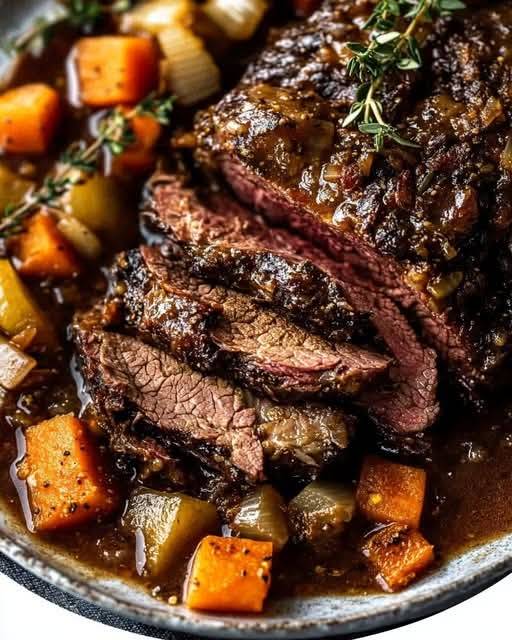Best Slow-Cooked Pot Roast with Vegetables: A Comforting Classic for Busy Weeknights
Nothing beats coming home to the rich aroma of the Best Slow-Cooked Pot Roast with Vegetables simmering in your kitchen. This hearty dish delivers tender beef that falls apart at the touch of a fork, surrounded by caramelized vegetables bathed in a savory gravy. Furthermore, the slow cooking process allows the flavors to develop into something extraordinary.
You will love how this recipe transforms simple ingredients into a showstopping meal with minimal effort. Whether you need a stress-free Sunday dinner or want to impress guests, this Best Slow-Cooked Pot Roast with Vegetables never disappoints. The melt-in-your-mouth texture and deep umami flavors make it a perennial family favorite.
Quick Recipe Highlights
- Flavor Profile: The combination of garlic, herbs, and Worcestershire sauce creates a robust umami base, while the vegetables add natural sweetness.
- Texture: The beef becomes incredibly tender during the long cooking process, while the vegetables maintain just the right amount of bite.
- Aroma: As the roast cooks, your kitchen fills with comforting scents of garlic, thyme, and caramelizing onions.
- Visual Appeal: The golden-brown roast surrounded by colorful vegetables makes an impressive centerpiece for any dinner table.
- Skill Level Needed: Beginners can master this recipe with ease since the slow cooker does most of the work.
- Special Equipment: You only need a reliable slow cooker or Dutch oven to achieve perfect results every time.
Recipe Overview
- Difficulty Level: This recipe earns its easy rating because it requires minimal hands-on time. After the initial preparation, the cooking process happens largely unattended.
- Category: Perfect as either a hearty main course for family dinners or an elegant option for entertaining.
- Cuisine: Rooted in American comfort food traditions with influences from French pot-au-feu techniques.
- Cost: Using affordable cuts like chuck roast keeps this dish budget-friendly while delivering premium flavor.
- Season: Ideal for cooler months but delicious year-round when you crave comforting flavors.
- Occasion: Works equally well for casual weeknight meals and special holiday gatherings.
Why You’ll Love This Recipe
The Best Slow-Cooked Pot Roast with Vegetables delivers exceptional taste with minimal effort. The long cooking time breaks down tough connective tissues in the beef, resulting in fork-tender meat that melts in your mouth. Meanwhile, the vegetables absorb all the delicious juices, becoming flavor-packed accompaniments to the star of the show.
Busy cooks appreciate how this recipe simplifies meal preparation. You can assemble everything in the morning and return hours later to a completed dinner. Additionally, the hands-off cooking method frees you to tackle other tasks while your meal cooks to perfection.
Nutritionally, this dish provides high-quality protein from the beef along with vitamins and fiber from the vegetable medley. The slow cooking method also helps retain more nutrients compared to faster cooking techniques. You get a balanced meal in one pot without sacrificing flavor or health benefits.
Entertaining becomes effortless with this crowd-pleasing recipe. Guests always appreciate the comforting familiarity of pot roast, while hosts love the make-ahead convenience. The impressive presentation also makes it perfect for serving at dinner parties or family celebrations.
Cost-conscious cooks will appreciate how this recipe stretches affordable ingredients into multiple satisfying meals. Tough cuts of beef become luxurious through the magic of slow cooking, and humble vegetables transform into delectable sides. Leftovers also taste fantastic, making this an economical choice for meal planning.
Historical Background and Cultural Significance
The tradition of slow-cooked pot roast traces back to centuries-old methods of tenderizing tough cuts of meat. Early European cooks developed these techniques to make the most of less expensive beef cuts. Immigrants later brought these methods to America, where they became staples of home cooking.
In American culinary history, pot roast gained prominence during the Great Depression as an economical way to feed families. The dish symbolized resourcefulness and comfort during challenging times. Today, it remains a nostalgic favorite that evokes memories of family gatherings and Sunday dinners.
The evolution of pot roast reflects changing kitchen technologies. While early versions relied on hearth cooking, the invention of the slow cooker revolutionized home preparation. Modern interpretations like our Best Slow-Cooked Pot Roast with Vegetables build on these traditions while incorporating contemporary flavors.
Regional variations abound across the United States. Some areas prefer tomato-based sauces, while others emphasize wine or beer braising liquids. Our version strikes a perfect balance with its rich, herb-infused gravy that complements rather than overwhelms the natural flavors of the beef and vegetables.
Ingredient Deep Dive
Chuck roast forms the foundation of our Best Slow-Cooked Pot Roast with Vegetables. This cut comes from the shoulder area and contains generous marbling that melts during cooking, creating incredible richness. When selecting chuck roast, look for even marbling and a bright red color. You can store it in the refrigerator for 2-3 days before cooking or freeze for longer storage.
Carrots add natural sweetness and vibrant color to the dish. These root vegetables have been cultivated for thousands of years and provide excellent sources of beta-carotene. Choose firm carrots with smooth skin and bright orange hue. They store well in the refrigerator for several weeks when kept in a plastic bag.
Potatoes contribute hearty texture and help thicken the cooking liquid. Russet potatoes work particularly well because they hold their shape during long cooking. Look for firm potatoes without sprouts or green spots. Store them in a cool, dark place away from onions to prevent premature sprouting.
Onions form the aromatic base of the dish, developing deep sweetness as they cook. Yellow onions offer the best balance of flavor and affordability. Select onions that feel heavy for their size with dry, papery skins. Properly stored in a cool, dry place, they can last for several weeks.
Common Mistakes to Avoid
- Choosing the wrong cut of meat: Lean cuts like sirloin will become dry and tough during slow cooking. Always select well-marbled chuck roast for best results.
- Skipping the searing step: Browning the meat first creates flavorful caramelization that enhances the entire dish. Take the time to develop this crucial flavor base.
- Overcrowding the pot: Leaving space between vegetables ensures even cooking and proper browning. Arrange ingredients in a single layer when possible.
- Adding vegetables too early: Root vegetables can become mushy if cooked the entire time. Add them during the last few hours for perfect texture.
- Using too much liquid: The vegetables release moisture during cooking. Start with less liquid than you think you’ll need to avoid a watery result.
- Neglecting to skim fat: Removing excess fat from the surface after cooking improves both flavor and healthfulness of the dish.
- Cutting the meat too soon: Letting the roast rest before slicing allows juices to redistribute, ensuring moist, tender results.
- Forgetting to season properly: Taste and adjust seasoning at the end since flavors concentrate during slow cooking.
Pro Tips for Perfect Best Slow-Cooked Pot Roast with Vegetables
For maximum flavor, season the roast generously with salt and pepper at least an hour before cooking. This allows the seasoning to penetrate the meat. Pat the surface dry before searing to ensure proper browning.
When searing the meat, use high heat and avoid moving it until a crust forms. This creates the Maillard reaction that develops complex flavors. Deglaze the pan with red wine or beef broth to capture all the tasty browned bits.
Layer ingredients strategically in the slow cooker. Place tougher vegetables like carrots and potatoes on the bottom where they’ll receive more direct heat. Position the meat on top to allow rendered fat to baste the vegetables.
Resist the temptation to lift the lid during cooking. Each peek releases valuable heat and steam, potentially adding significant time to the cooking process. Trust the process and let the slow cooker work its magic.
For a thicker gravy, remove the cooked vegetables and meat, then simmer the liquid uncovered for 15-20 minutes. Alternatively, make a slurry with cornstarch and water to thicken the juices quickly.
Variations and Adaptations
For a Mediterranean twist, add sun-dried tomatoes, Kalamata olives, and rosemary to the pot. Substitute red wine for some of the broth and finish with a sprinkle of feta cheese. The bright flavors complement the rich beef beautifully.
During summer months, try lighter vegetable combinations. Zucchini, yellow squash, and cherry tomatoes add fresh flavors while maintaining the comforting essence of the dish. Serve with crusty bread to soak up the delicious juices.
Dietary adaptations work well with this versatile recipe. For gluten-free versions, use cornstarch instead of flour for thickening. Those watching carbs can replace potatoes with turnips or radishes, which become surprisingly sweet when slow-cooked.
Experiment with different herb combinations to change the flavor profile. Try herbes de Provence for a French accent, or smoked paprika and cumin for Southwestern flair. The basic technique remains the same while the seasonings create exciting new variations.
Serving and Presentation Guide
For family-style serving, arrange the sliced beef on a large platter surrounded by the vegetables. Spoon some of the cooking liquid over the top and garnish with fresh thyme sprigs. This creates an inviting presentation that showcases the dish’s rustic elegance.
Individual plating works beautifully for more formal occasions. Place a slice of beef slightly off-center on each plate, then artfully arrange the vegetables around it. Drizzle with reduced cooking liquid and add a sprinkle of chopped parsley for color contrast.
Traditional accompaniments include creamy mashed potatoes or buttered egg noodles to soak up the delicious gravy. For lighter options, serve with crusty whole-grain bread or a simple green salad dressed with vinaigrette.
Temperature matters when serving pot roast. Allow the meat to rest for 10-15 minutes after cooking, but serve while still warm. Reheat the plates briefly if needed to ensure everything arrives at the table piping hot.
Wine and Beverage Pairing
Full-bodied red wines complement the rich flavors of Best Slow-Cooked Pot Roast with Vegetables beautifully. Look for Cabernet Sauvignon or Syrah with enough tannins to stand up to the hearty dish. These wines cut through the richness while echoing the meat’s savory notes.
For white wine lovers, choose an oaked Chardonnay with enough body to match the dish’s weight. The buttery notes in the wine will harmonize with the caramelized flavors in the pot roast.
Non-alcoholic options include rich beef broth-based drinks or tart cherry juice mixed with sparkling water. The acidity helps balance the dish’s richness while providing refreshing contrast.
When serving beer, opt for malty varieties like brown ales or porters. These beers mirror the roasted flavors in the dish without overwhelming the palate. Avoid overly hoppy IPAs that might clash with the savory elements.
Storage and Shelf Life
Properly stored, leftover Best Slow-Cooked Pot Roast with Vegetables maintains excellent quality for 3-4 days in the refrigerator. Cool the dish completely before transferring to airtight containers. Store the meat and vegetables together with enough cooking liquid to keep them moist.
For longer storage, freeze portions in freezer-safe containers for up to 3 months. Thaw overnight in the refrigerator before reheating. The texture may soften slightly after freezing, but the flavors remain delicious.
When reheating, do so gently to prevent the meat from becoming tough. Use the microwave at reduced power or warm on the stovetop over low heat. Adding a splash of broth or water helps maintain moisture during reheating.
Signs of spoilage include off odors, slimy texture, or mold growth. When in doubt, discard questionable leftovers. The high moisture content makes this dish particularly susceptible to bacterial growth if improperly stored.
Make Ahead Strategies
For ultimate convenience, prepare the entire dish up to two days in advance. The flavors often improve after a night in the refrigerator. Simply reheat gently before serving, adding a little broth if needed to refresh the consistency.
Another time-saving approach involves prepping ingredients the night before. Season and sear the meat, then refrigerate it separately from the chopped vegetables. In the morning, simply assemble everything in the slow cooker and start the cooking process.
Consider making a double batch of the cooking liquid and freezing half. This flavorful base speeds up future preparations. You can also freeze pre-measured seasoning blends for instant flavor boosts.
For last-minute freshness, prepare garnishes like chopped herbs or citrus zest ahead of time. Store them in small containers in the refrigerator to sprinkle over the finished dish just before serving.
Scaling Instructions
Doubling the recipe works well if you have a large enough slow cooker. Maintain the same proportions of ingredients but extend the cooking time by 1-2 hours to account for the increased volume. Check for doneness by testing the meat’s tenderness.
When halving the recipe, reduce the cooking time by about 25 percent. Smaller quantities cook faster, so monitor the pot roast closely to prevent overcooking. The vegetables may need less time as well.
For large gatherings, consider cooking multiple smaller roasts rather than one enormous piece of meat. This ensures more even cooking and better texture throughout. Use separate slow cookers or cook in batches if necessary.
Remember to adjust seasoning amounts proportionally when scaling the recipe. However, you may need slightly less salt per pound when increasing quantities, as flavors concentrate during slow cooking.
Nutritional Deep Dive
The Best Slow-Cooked Pot Roast with Vegetables provides balanced nutrition in every serving. The beef delivers high-quality protein along with essential nutrients like iron, zinc, and B vitamins. These support muscle maintenance, immune function, and energy metabolism.
Vegetables contribute fiber, vitamins, and antioxidants to the dish. Carrots provide beta-carotene for eye health, while onions offer quercetin with anti-inflammatory properties. Potatoes contribute potassium, important for blood pressure regulation.
While the dish contains some saturated fat from the beef, you can reduce this by trimming visible fat before cooking and skimming excess fat from the surface afterward. The slow cooking method also renders out much of the fat naturally.
For those watching carbohydrates, you can adjust the vegetable ratios to include more low-carb options like mushrooms and green beans. The protein-rich beef makes this dish satisfying even with reduced starchy components.
Dietary Adaptations
Gluten-free versions simply require ensuring all packaged ingredients like broth or Worcestershire sauce are certified gluten-free. Thicken the sauce with cornstarch instead of flour if needed. The basic recipe already contains no gluten-containing ingredients.
For dairy-free needs, this recipe naturally fits the bill. None of the core ingredients contain dairy, though you should check labels on prepared broths or sauces if using store-bought versions.
Low-carb adaptations focus on reducing starchy vegetables. Replace potatoes with cauliflower or turnips, and increase the proportion of low-carb vegetables like mushrooms, zucchini, and bell peppers. The beef remains an excellent protein source for low-carb diets.
Paleo followers can enjoy this dish with minimal modifications. Use coconut aminos instead of Worcestershire sauce if avoiding soy, and ensure any broth used contains no non-Paleo additives. The simple, whole-food ingredients align perfectly with Paleo principles.
Troubleshooting Guide
If your pot roast turns out tough, it likely needed more cooking time. Return it to the slow cooker with additional liquid and continue cooking until tender. Toughness usually indicates insufficient breakdown of connective tissues.
For watery results, remove the solids and reduce the liquid on the stovetop. Alternatively, thicken with a cornstarch slurry. Next time, use less liquid initially since vegetables release moisture during cooking.
Bland flavors often result from underseasoning. Remember that slow cooking mutes seasonings, so be generous with salt and herbs. You can always adjust seasoning at the end of cooking.
If vegetables become mushy, they probably cooked too long. Next time, add root vegetables during the last 3-4 hours of cooking rather than at the beginning. More delicate vegetables like mushrooms need even less time.
Frequently Asked Questions
Can I cook this recipe in an Instant Pot instead? Yes, you can adapt it for pressure cooking. Sear the meat using the sauté function, then cook on high pressure for about 60 minutes with natural pressure release.
What’s the best cut of meat for pot roast? Chuck roast remains the top choice for its perfect balance of flavor and marbling. Other good options include brisket or bottom round, though cooking times may vary slightly.
Can I add other vegetables to the recipe? Absolutely. Root vegetables like parsnips or turnips work well, as do mushrooms or celery. Just adjust cooking times based on the vegetables’ density.
How do I know when the pot roast is done? The meat should shred easily with a fork when properly cooked. An instant-read thermometer should register at least 190°F for optimal tenderness.
Can I make this recipe without wine? Certainly. Substitute additional beef broth or even coffee for depth of flavor. The wine adds complexity but isn’t essential to the dish’s success.
Why does my pot roast taste dry? This usually happens from overcooking or using too lean a cut. Ensure you select well-marbled meat and monitor doneness carefully.
Can I prepare this dish overnight? Yes, many slow cookers have timers that allow you to program cooking times. Just ensure the cooker switches to “warm” after cooking to maintain food safety.
What’s the best way to thicken the gravy? For a smooth result, make a slurry with equal parts cornstarch and cold water, then whisk into the hot cooking liquid until thickened.
Can I freeze leftovers? Yes, pot roast freezes beautifully. Store in airtight containers with some cooking liquid to maintain moisture. Thaw in the refrigerator before reheating.
How can I add more flavor to my pot roast? Try browning tomato paste with the onions, adding umami boosters like mushrooms or soy sauce, or using a flavored broth as your cooking liquid.
Additional Resources
For more slow cooker inspiration, explore our collection of comfort food classics. We offer recipes for everything from tender pulled pork to creamy soups that make weeknight dinners effortless.
Those interested in mastering beef cookery will appreciate our guide to different cuts and cooking methods. Learn how to select the perfect roast for every occasion and technique.
Vegetable lovers can discover our seasonal produce guides, highlighting the best choices for slow cooking. These resources help you create balanced, flavorful meals year-round.
For entertaining ideas, browse our make-ahead dinner party menus. These stress-free plans help you host with confidence, featuring dishes like our Best Slow-Cooked Pot Roast with Vegetables as centerpieces.
PrintBest Slow-Cooked Pot Roast with Vegetables
Description
A tender and flavorful pot roast slow-cooked with hearty vegetables for a comforting meal.
Ingredients
For the Crust:
- 3 lbs chuck roast
- 2 tbsp olive oil
- 1 large onion, chopped
- 4 carrots, peeled and chopped
- 4 potatoes, peeled and cubed
- 3 cloves garlic, minced
- 2 cups beef broth
- 1 tbsp Worcestershire sauce
- 1 tsp dried thyme
- 1 tsp dried rosemary
- Salt and pepper to taste
Instructions
1. Prepare the Crust:
- Heat olive oil in a large skillet over medium-high heat. Season the chuck roast with salt and pepper, then sear on all sides until browned.
- Transfer the roast to a slow cooker. Add onions, carrots, potatoes, and garlic around the roast.
- In a bowl, mix beef broth, Worcestershire sauce, thyme, and rosemary. Pour over the roast and vegetables.
- Cover and cook on low for 8 hours or on high for 4-5 hours, until the meat is tender.
- Remove the roast and vegetables, then skim excess fat from the cooking liquid. Serve the roast sliced with vegetables and gravy.
Notes
You can customize the seasonings to taste.





